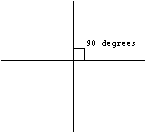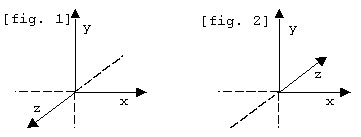
Hi there! Relsoft again back with an article for you. :*). This article is the first of a series of 3d articles that I'll be serializing at qbasicnews.com. I don't know how far I could take you or how many chapters will I make. It depends upon the user feedback and my free time. ;*)
I'm most likely to cover a lot of things that after you've read the whole series, you're likely to be able to make your own FPS render, a 3d strategy game or even a Ragnarok style engine. ;*)
What I will be covering in this series are listed below:
The purpose of this article is to try to explain the reasons behind 3d projection and a little on 2d rotation. 3d is only as hard, or as easy, as you want it to be. Don't be afraid as I'll take you to the world of 3d step by step.
What you need to be able to run the sample programs that I will be throwing from time to time is any flavor of QuickBASIC (QBASIC, QB 4.5, 7.1, etc). A little experience in algebra and Trig is also a plus but not necessary. I will also try to explain optimization techniques as we go along the whole series. ;*)
The 3d cartesian coordinate system is almost like the 2d cartesian coordinate system that we grew up with, only with an extra dimension: The Z axis. *There are several other 3d coordinate systems like spherical and cylindrical. I will explain them to you in detail in future issues, but when I talk 3d coordinates for now, its the cartesian coordinate system unless specified.
ie.But how do we define a 3d coordinate? Where does the z-axis go? As we know already, in 2d coordinate, the x-axis is going to the right and the y-axis is going up. The 2 axes (plural for axis) intersect at p(0,0). Read as "Point 0,0" where the first value is the x (abscissa) and the second value is the y (ordinate). P(0,0) is also called the "Origin". They are also PERPENDICULAR to each other. Perpendicular means a line, plane or a ray (vector) which has a union of 90 degrees. Meaning they form a "+" when they intersect.

See how all the angles (1, 2, 3, 4) are all 90 degrees? That's the essence of perpendicularity. Also be sure that you understand this concept as perpendicularity is used on almost all things that got to do with 3d. *Perpendicular lines/Planes/rays are also called "orthogonal".
There is not that much difference in 3d, all the axes are perpendicular to each other. ie: Z axis is perpendicular to the XY Plane, Y axis is perpendicular to the XZ plane as the X axis to the YZ plane. Now how about the directions the axes go? Well, there are two ways to define a 3d system. The "RIGHT-HANDED" and the "LEFT-HANDED" systems. The choice is yours to make, or me in this case because I'm the one writing this article.

Since most books use the right handed system, I'll use that system. Another reason is that the coordinates when plotted on the screen, resembles a real-world system. Hey, I'm right handed. ;*)
As you might have guessed, QB has no PSET3d or LINE3d routine so we have to make one. :*) The beauty of learning the theories and principles behind how things work is that you won't get lost at discussions on forums. :*) So let me start by the principle:
Normal way: "The farther the thing from the viewer the smaller it gets"
Jocke's way: "I'm gonna kick this ball so far you won't be able to see it."
Math way: "Distance is inversely proportional to the size of an object"
Trying to make an equation using Jocke's or the English statement would be very hard. So we'll use the Math way:
so:
assume:
*This is just an approximation. Just to show you the relationship of size and distance.
Now you would want to project and object but how do we do it with the knowledge that we have already learned? Well, First, we have to decide where z=0 is. Turns out that a good way to define z=0 is a number of units away from you. Which means that you can see it when you look at your monitor. A good value is 256. Why 256? Well, this is not entirely the law since you could make it as small or as big as you want it to be, but 256 is a good multiplier (or any power of 2 value) as you will see later. Secondly, where to put the monitor in our 3d space. Think of your monitor as a "camera" that points onto the 3d space and the screen as the LENS (camera lens) perpendicular to the z-axis (Yes, your XY plane). Since (0,0,0) or z=0 is at a distance of 256 looking at the negative direction, our Lens should be 0+256. So that the coordinate of our lens is (0,0,256).
Anything more than 256 is behind the camera and should not be plotted. Remember that we are looking on the negative z in right-handed systems.
And why did we use 256?
Seasoned programmers would know that 256 is a power of two. Since you can use shifts to multiply and divide, you could make your renders faster by miles as shifts are way faster than divs or muls. ;*)
In screen 13, the dimensions of the screen is 320*200 and its center is (160,100). We know that at z=0, the relationship of each x,y,z units is that x and y is one unit wide. So plotting (8,5,0):
Then:
How about if z = 128? (8,5,128)
Then:
128 is nearer which means the size of the units should increase. But how much? Since 128 is half of 256, our units should be 2x (twice) the size of the units at z=0. So...
Then:
Pretty easy huh? Putting it all together, the projection would look like this:
Now let me explain how each component affects the whole projection formula:
We know that LENS, the lens of our camera or monitor in this case, is a multiplier to give your projection a field of view(FOV) and since the camera is 256 units away from (0,0,0) we would want the value of our lens to have a direct correlation with distance. eg:
(See the relationship already?)
* some people use a value of Lens=1 so that it weeds out 2 muls or shifts in the actual projection formulas but in my experience, the objects does not look "natural".
This is just how far a 3d pixel is away from the camera. Since we look in the negative direction, "The farther the distance, the smaller the z value. ie. p(0,0,-100) is further than p(0,0,100). Let us see if this holds true in equation form.
Ahem! 356>156. ;*)
What about z=>256 or distance is 0 or less? Well, unless you want to poke yourself in the eye, you wouldn't want to plot em. ;*) Plotting at distance=0 is technically correct but you had to change your projection formula because n/0 is undefined. And in geometry, "Distance is always positive :*)" Here's the formula:
To test your intelligence, I'll let you think about it yourself. ;*)
or (since addition is commutative):
Now let's see if the projection equations would return the same values for (8,5,128): Remember that we returned x=176, y=90)
Ahem...;*)
Translation is just movement of a point from one location to another. To simplify things, I put the translation coords in the form of a camera offsets, camx,camy,camz.
Moving the location of the point is just as simple as adding or subtracting values to the camera offsets and subtracting those components; x,y & z from p(x,y,z) ie:
Now for the fun part, plotting! Let's start by the simplest of all "models" (When I say models i mean an array of points that define a 3d object), the plane. In this case we want to plot a grid of 16*16 plane. As we would want the grid to be centered at x=0 and y=0, the starting x and y values of our grid is negative. We also would want to start at z=0 adding an increment(20) for every y-loop. We also would want to scale the distance between each point, in this case 4.
Now to project it,
Now here's the example file of a projected plane:
(camera is controlled by AZSXDC)
project.bas
You can even project texts:
projchar.bas
Here's how you can apply the projection equations to a starfield:
projstar.bas
Pixels alone tend to be boring after a while. So why not use sprites? Considering we also have to project the size of the sprite or tile, we can't use the normal QB PUT routine, so we have to make a stretch sprite routine for this purpose alone. The algo behind the stretch sprite routine is pretty trivial so I won't explain it here in detail. All you have to remember is that you could zoom or pan on a sprite depending on the parameters, NewHeight and NewWidth.
For the actual algo in calculating the new dimensions, here's the formula:
OldWidth and OldHeight are the actual dimensions of the sprite. Ie. If you GET(0,0)-(15,15),Array then the size of the sprite is 16*16. So OldHeight=16 and OldWidth=16.
Distance is the same distance in out projection equations. Same with the LENS. I'll let you figure out the rationale behind the equations yourself. :*)
Here's the sample file:
meteor.bas
stars.bas
Hope you've learned something from this. The best way to learn though is to just play with the values, running the program and see the effect of the changed values.
Next time, I will teach you 2d and 3d rotations, polar coodinates, other forms of transformation besides translation, optimizations of 3d rotations using constants, and probably if space will provide 3d model generation (The math way). So you might want to read on:
*Don't worry even if you don't know a thing about those things I mentioned because I will be teaching you all of those next issue as if you're am 8 year-old kid. ;*)
So until next time, Relsoft signing out. Happy coding!!!!
Relsoft 2003
| Author: | Rel (Richard Eric M. Lope) |
| Email: | vic_viperph@yahoo.com |
| Website: | http://rel.betterwebber.com/ |
| Released: | 2004 |